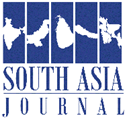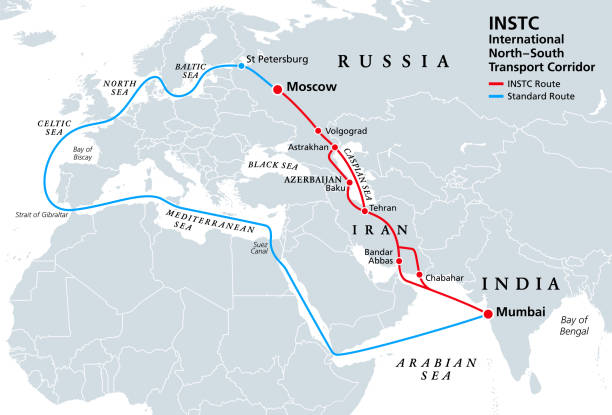
The International North-South Transport Corridor (INSTC) is a 7,200 km multi-modal transportation network that connects India to Russia via Iran. The corridor involves a combination of ship, rail, and road routes to facilitate the movement of freight between the member countries. The other ten nations such Armenia, Azerbaijan, Belarus, Kazakhstan, Kyrgyzstan, Tajikistan, Turkey, Ukraine, Oman, and Syria have joined the INSTC so far. The implementation of the Corridor could lead to a shift in regional alliances, as countries seek to align themselves with the most promising economic opportunities. The corridor can be perceived as part of India’s strategy to diplomatically and politically isolate Pakistan, a tactic it has frequently employed. This could result in Pakistan being side-lined as countries like India and Iran forge closer ties with Russia and Central Asian states. This could have significant implications for Pakistan’s regional influence and its ability to maintain a balance of power in the region.
Keeping this threat in mind, Pakistan has decided to join the INSTC after receiving an invitation from Russian President Vladimir Putin and has begun the membership process. Since the past few years, Russia is looking forward to improve its bilateral relations with Pakistan as it can be a key player in countering the western bloc. It places significant importance on its cooperation with Pakistan within the framework of the Shanghai Cooperation Organization (SCO). Russia has also welcomed Pakistan’s bid to join the BRICS in November 2023. Policy Pundits assert that it will further support Pakistan in its successful membership by taking the advantage of the chairmanship in the upcoming Summit this year.
Pakistan’s agreement to join the INSTC presents significant opportunities for her to boost its economy, improve regional connectivity, and strengthen strategic partnerships. It would provide a forum to strengthen its geopolitical position, diplomatic relations, promote economic cooperation, and foster regional stability. This will help Pakistan establish itself as a major player in regional affairs and exert influence on major economic and political decisions. These alliances will help Pakistan leverage its unique geographic location, strengthen trade and investment ties, and enhance its regional influence.
Moreover, joining the INSTC will enable Pakistan to diversify its trade routes, reduce dependence on traditional routes, particularly the Suez Canal, and improve economic resilience. By connecting with Russia, Iran, and India, Pakistan will be able to access new markets, expand export opportunities, and attract foreign investment. This diversification will help Pakistan reduce the risks associated with over-reliance on particular trade routes and markets and improve economic competitiveness.
The question arises regarding the corridor’s potential to improve the relations between Pakistan and India as there is no doubt in the corridor’s ability to intensify the economic competition between the two rivals. India’s active involvement in the corridor, aiming to enhance its geopolitical influence in Central Asia and beyond, poses a direct economic threat to Pakistan’s interests. India’s investments in ports like Chabahar in Iran, strategically positioned to connect with Central Asia and Afghanistan, could divert trade routes and economic opportunities away from Pakistan, impacting its economic growth and regional influence.
Once a part of the corridor, Pakistan can counter this challenge and compete with India with a stronger position. The corridor has the potential to revolutionize economic relations between the two states, facilitating both international trade and commerce along the Line of Control (LoC), which have long been strained. This could also provide a platform for both states to strengthen their political ties by resolving their issues, as in the new world order, states prefer economic ties over diplomatic ones. By actively participating in this corridor and strengthening economic ties with Central Asian countries, Pakistan can limit India’s ability to dominate regional trade and investment.
However, expectations are tempered as India has consistently avoided cooperation with Pakistan and sought to hinder its progress. For instance, during the BRICS Summit 2022, India was the sole country to oppose Pakistan’s participation in a virtual dialogue for non-member states. Additionally, at an SCO Seminar in 2023, India exploited its chairmanship to block Pakistan’s attendance. These are a few examples highlighting India’s on-going reluctance to engage in any form of cooperation or dialogue with Pakistan. This dynamic may present a challenge for Pakistan in its efforts to successfully integrate and participate in the INSTC.
In May 2024, India Ports Global Limited (IPGL) entered into a 10-year agreement with the Ports and Maritime Organization of Iran. This deal permits New Delhi to develop and manage the port of Chabahar. IPGL is set to invest approximately $120 million, with an additional $250 million in financing, resulting in a total contract value of $370 million. This could diminish Pakistan’s strategic value and limit its ability to leverage its geographical position for economic and political gain. The signing of a long-term agreement on Chabahar Port holds strategic importance due to its anticipated role in the INSTC.
Such a scenario has the potential to strain Pakistan’s relations with Iran as both countries compete for regional influence and economic opportunities. Chabahar Port, which is being developed with Indian assistance, is seen as a rival to Pakistan’s Gwadar Port. This could lead to increased tensions between the two countries and limit their ability to cooperate on regional issues. However, Pakistan’s entrance into the INSTC could counter this threat to some extent as it would not be completely bypassed and could also improve the bilateral relations with Iran.
In addition to that, Pakistan’s accession to the INSTC will give it access to the markets of Central Asian countries which have a combined GDP of over $300 billion and a population of over 70 million people. By establishing trade relations with these countries, Pakistan can diversify its export destinations and tap into new sources of economic growth. Moreover, Pakistan will gain access to Central Asia’s rich natural resources such as oil, gas, and minerals, helping meet Pakistan’s growing energy needs and supporting industrial development.
Interestingly, if Pakistan joins the INSTC, the China-Pakistan Economic Corridor (CPEC) could also benefit in several ways. The Gwadar Port can play an important role in the INSTC by serving as a trade gateway between South Asia, Central Asia, and the Middle East. By connecting Gwadar with Chabahar port and the INSTC network, Pakistan can position itself as a major transit hub and earn revenue from transit fees and trade-related activities. By integrating the CPEC with the INSTC, Pakistan can strengthen regional connectivity and facilitate trade and investment flows between China, Pakistan, and other NSTC member states.
Furthermore, the development of industrial and commercial zones along the INSTC route has the potential to attract investment and stimulate economic activity in Pakistan. These zones can serve as manufacturing, storage, and distribution hubs, creating job opportunities and spurring economic growth in areas such as Gwadar and along the CPEC.
Analysts highlight the importance of balancing diplomatic relationships with major global and regional powers and harmonizing customs and trade regulations for seamless transit of goods. Security of transport routes against threats such as terrorism and smuggling is critical. Additionally, challenges like the Indian factor, potential U.S. sanctions, and regional connectivity issues pose policy hurdles for Pakistan’s participation in the INSTC. Rapidly changing socio-economic and geopolitical dynamics, along with concerns about terrorism and non-state actors, have previously deterred Pakistan from joining this regional connectivity project.
To successfully integrate into the INSTC, Pakistan needs to take several strategic measures. Strengthening connectivity by establishing a rail link between Gwadar and Chabahar ports, investing in transport infrastructure, and simplifying trade practices like customs procedures are essential. Enhancing regional cooperation with member states, especially India and Iran, through bilateral agreements and joint ventures is crucial. Managing geopolitical risks due to regional conflicts and political instability in neighbouring countries, particularly Iran and Afghanistan, is also vital. Ensuring the safety of infrastructure projects, especially in Balochistan, is necessary to attract investments and ensure success.
With a successful inclusion and integration into the INSTC, Pakistan can solidify its role as a pivotal regional connectivity hub, seamlessly linking South Asia, Central Asia, and the Middle East. This enhanced connectivity is poised to boost trade flows, attract investments, and facilitate cultural exchanges, thereby promoting regional cooperation and stability. Nevertheless, it has the potential to contribute significantly to Pakistan’s development goals, such as its ambition to progress from a lower-middle-income nation to an upper-middle-income nation by 2025.



0 Comments
LEAVE A COMMENT
Your email address will not be published